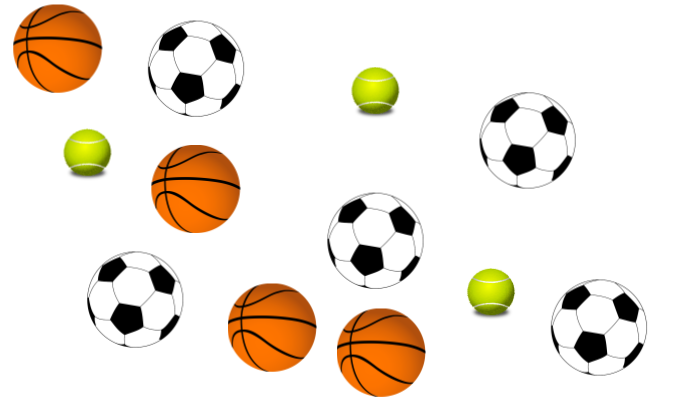1.1 Adding, Subtracting, and Working with Data
Unit Goals
- Students add and subtract within 10, and represent and interpret categorical data.
Section A Goals
- Build toward fluency by adding and subtracting within 10 in a way that makes sense to them.
Section B Goals
- Organize and represent data.
Section C Goals
- Interpret data representations to ask and answer questions.
Section A: Add and Subtract within 10
Problem 1
Pre-unit
Practicing Standards: K.G.A.2
Color in the shapes that are triangles.




Solution
For access, consult one of our IM Certified Partners.
Problem 2
Pre-unit
Practicing Standards: K.OA.A.1
How many do you see?
-
____________
-
____________
Solution
For access, consult one of our IM Certified Partners.
Problem 3
Pre-unit
Practicing Standards: K.OA.A.1
- Match the pictures with the expressions.
Solution
For access, consult one of our IM Certified Partners.
Problem 4
How many do you see?
-
____________
-
____________
Solution
For access, consult one of our IM Certified Partners.
Problem 5
Circle the expression that matches the dots.

\(2+2\)
\(4+3\)
\(3+3\)
Solution
For access, consult one of our IM Certified Partners.
Problem 6
Circle the dots that match the expression: \(5+1\)



Solution
For access, consult one of our IM Certified Partners.
Problem 7
Find the value of each sum.
- \(3 + 1\)
- \(3 + 2\)
- \(7+2\)
- \(7+1\)
Solution
For access, consult one of our IM Certified Partners.
Problem 8
Find the value of each difference.
- \(10 - 1\)
- \(10-2\)
- \(5-2\)
- \(6-1\)
- \(8-2\)
Solution
For access, consult one of our IM Certified Partners.
Problem 9
Show 2 ways you could use these cards in the game.

\(\underline{\hspace{1.7cm}} + \underline{\hspace{1.7cm}} = \underline{\hspace{1.7cm}}\)
\(\underline{\hspace{1.7cm}} - \underline{\hspace{1.7cm}} = \underline{\hspace{1.7cm}}\)
Solution
For access, consult one of our IM Certified Partners.
Problem 10
Exploration
Materials needed:
- Number cards 2–10
- Two dot cubes
Directions:
- Choose a number card.
Show 2 numbers on the dot cubes that add to make your number. - Can you show another way?
Solution
For access, consult one of our IM Certified Partners.
Problem 11
Exploration
Partner A: Hold up some fingers on each hand.
Partner B: Fill in the blanks to show how many:
\(\underline{\hspace{1.7cm}} + \underline{\hspace{1.7cm}} = \underline{\hspace{1.7cm}}\)
Switch roles and play again.
\(\underline{\hspace{1.7cm}} + \underline{\hspace{1.7cm}} = \underline{\hspace{1.7cm}}\)
\(\underline{\hspace{1.7cm}} + \underline{\hspace{1.7cm}} = \underline{\hspace{1.7cm}}\)
\(\underline{\hspace{1.7cm}} + \underline{\hspace{1.7cm}} = \underline{\hspace{1.7cm}}\)
Solution
For access, consult one of our IM Certified Partners.
Section B: Show Us Your Data
Problem 1
Here are some objects.

- What are 2 categories you can use to sort these objects?
- What are 2 different categories you can use to sort these objects?
Solution
For access, consult one of our IM Certified Partners.
Problem 2
Here are some objects.

- Show how you could sort the balls into categories.
-
How many balls are in each category?
category 1:____________
category 2:____________
category 3:____________
Solution
For access, consult one of our IM Certified Partners.
Problem 3
How are these representations the same?
How are they different?


Solution
For access, consult one of our IM Certified Partners.
Problem 4
Exploration
Gather data from the classroom or home.
Sort your data into categories.
Show how you sorted the data on paper.
Solution
For access, consult one of our IM Certified Partners.
Problem 5
Exploration
There are 15 pattern blocks in a bag.
There are squares, triangles, and hexagons.
The chart shows how many squares are in the bag.

Find as many solutions as you can.
Solution
For access, consult one of our IM Certified Partners.
Section C: What Does the Data Tell Us?
Problem 1
Jada showed how she sorted some shapes.

Jada made statements about how she sorted.
Decide whether each statement is true or false.
- There are 6 triangles.
- There are 15 shapes altogether.
- The number of shapes that are squares or triangles is the same as the number of circles.
Solution
For access, consult one of our IM Certified Partners.
Problem 2
A class was asked about their favorite birds at the zoo.
Their responses are shown here.

Write 3 things that you learned about the class’ favorite birds at the zoo.
Solution
For access, consult one of our IM Certified Partners.
Problem 3
Use the data to answer the questions.

-
How many students chose dogs?
\(\underline{\hspace{1.5cm}}\)
-
How many students chose birds?
\(\underline{\hspace{1.5cm}}\)
-
How many students chose dogs or cats?
\(\underline{\hspace{1.5cm}}\)
-
How many students chose cats or birds?
\(\underline{\hspace{1.5cm}}\)
-
How many students took the survey?
\(\underline{\hspace{1.5cm}}\)
Solution
For access, consult one of our IM Certified Partners.
Problem 4
Use the data to answer the questions.

-
How many students chose yogurt?
\(\underline{\hspace{1.5cm}}\)
-
How many students chose apple?
\(\underline{\hspace{1.5cm}}\)
-
How many students chose apple or nuts?
\(\underline{\hspace{1.5cm}}\)
-
How many students chose apple or yogurt?
\(\underline{\hspace{1.5cm}}\)
-
How many students took the survey?
\(\underline{\hspace{1.5cm}}\)
Solution
For access, consult one of our IM Certified Partners.
Problem 5
Crayons are sorted into categories based on color.

What are 2 questions that you can ask about the crayons?
Solution
For access, consult one of our IM Certified Partners.
Problem 6
Exploration
Use the data to answer the question.

If the answer to a question about this data is 13, what could the question be?
Solution
For access, consult one of our IM Certified Partners.
Problem 7
Exploration
- Gather data at home or school and make a display of the data.
- Ask a math question about the data.
- Trade displays and questions with a partner and answer your partner’s question.
Solution
For access, consult one of our IM Certified Partners.







